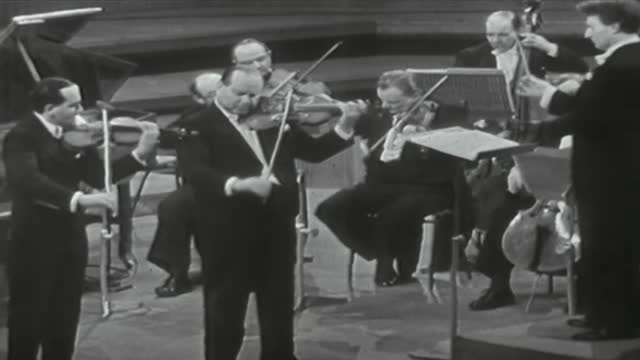David Oistrakh was one of the many illustrious violinists from Odessa who were pupils of the remarkable teacher Piotr Stolyarsky. Unusually for his time Oistrakh did not go to Leopold Auer, remaining in Odessa under Stolyarsky’s instruction until graduating in 1926. His name became known in the West in 1935 when he was runner-up to Ginette Neveu in the Wieniawski Competition; he was also honoured with several important prizes in the USSR.
Oistrakh’s career, like those of many others in the Stalin era, was circumscribed by Stalin’s direct influence upon the arts. World War II demanded astonishing bravery from him, playing for troops and indeed continuing a performance of Tchaikovsky’s Violin Concerto to its end during the Battle of Stalingrad in 1942. Towards the end of the war he formed a friendship with Shostakovich who had experienced the siege of Leningrad at first hand.
Most of Oistrakh’s substantial discography dates from after the war and some of the recordings in this selection were made in the West, Oistrakh only being allowed to leave the USSR in 1946. It is almost impossible to do justice to him in such a tight space, but a number of recordings representing particularly high pinnacles of his career serve as a starting point.
Oistrakh showed considerable interest in earlier music and German repertoire. His approach to Baroque style is demonstrated here by a fine Bach E major Concerto under Ormandy in 1955. Like most violinists of this time he makes no discernible concessions to Baroque performance practice, playing the work in very much the same way as later repertoire. This can grate on recent historically-informed sensibilities, but such is his power and directness that these distinctions are soon forgotten and the Bach slow movement, with a comparatively tight, controlled vibrato and Oistrakh’s trademark tonal intensity, is astonishingly moving. The lighter, more galant style of Viennese Classicism is arguably less well-suited to this sound, and his Mozart B flat Sonata with Yampolsky from 1954 is, although a high-quality rendition, not especially interesting. Beethoven’s Op. 47 ‘Kreutzer’ Sonata (recorded in 1953) – by this time a celebrated proving-ground for technical and artistic prowess in duo repertoire – is delivered with rock-solid technical assurance and tonal power, distinguished by Oistrakh’s tendency to use quite short staccati at the heel of the bow, evidenced in the outer movements.
It is perhaps in the major violin concertos that Oistrakh’s prowess is best diplayed. His Mendelssohn recording under Ormandy (1955) is powerful but also tonally rather deeper and richer than, for example, Heifetz’s approach to the work. Oistrakh’s is a more eloquent lyricism: he was a master of vocal-style bowing, laying great stress upon the similarites between bowing and breathing. His dislike of excessive sliding between positions and the over-use of vibrato testifies to a sensitive and discriminating artistic approach. Unsurprisingly perhaps, Oistrakh does use an off-string bow stroke in the finale (in contravention of Joachim’s insistence that this is not what Mendelssohn desired), but it has a solid and sonorous quality that overrides at least some of this criticism.
He recorded the Khachaturian and Shostakovich concertos several times; the featured recordings demonstrate Oistrakh’s extraordinary qualities in the works of his contemporaries. Shostakovich’s Concerto No. 1 with Mitropoulos and the New York Philharmonic (1956) shows the high regard in which US musicians held their Soviet counterparts. This gigantic work of profound sorrow, passionate intensity and – in the Scherzo – barbaric ferocity is given an electric reading by its dedicatee. The opening movement has some tuning discrepancies but these are soon forgotten as Oistrakh’s bitter-sweet tone, of great depth and haunting power, transports us to the very core of the work. The slow movement begins with rather exaggerated accents in the brass triplets and initially Oistrakh’s playing of this expansive passacaglia is rather regular and over-projected, but as the movement advances it is clear that this assertive style is part of a strategy to build, progressively, the heart-rending intensity of his playing. Here Oistrakh displays tonal characteristics that were unmistakably his own: a very firm bow stroke with plenty of length, as film footage shows us, very much ‘into the string’; and a tendency to integrate vibrato with open strings and pure tones (something that Henry Roth criticises in several Soviet violinists). The finale, with amazingly fleet, clean and articulate heel-of-the-bow playing is relentless and powerful. The Khachaturian recording of 1954 has similar traits.
Oistrakh’s relatively early demise was a tragedy, but many of his qualities were inherited by his son Igor, who is discussed below.
© Naxos Rights International Ltd. — David Milsom (A–Z of String Players, Naxos 8.558081-84)
| Title | |
| BACH, J.S.: Concerto for 2 Violins / MOZART, W.A.: Sinfonia concertante / BRAHMS, J.: Violin Concerto (D. and I. Oistrakh) | |

|
BACH, J.S.: Concerto for 2 Violins / MOZART, W.A.: Sinfonia concertante / BRAHMS, J.: Violin Concerto (D. and I. Oistrakh)
Composers:
Bach, Johann Sebastian -- Brahms, Johannes -- Mozart, Wolfgang Amadeus
Artists:
Davis, Colin -- English Chamber Orchestra -- Kondrashin, Kirill -- Menuhin, Yehudi -- Moscow Philharmonic Orchestra -- Oistrakh, David -- Oistrakh, Igor
Label/Producer: ICA Classics |
